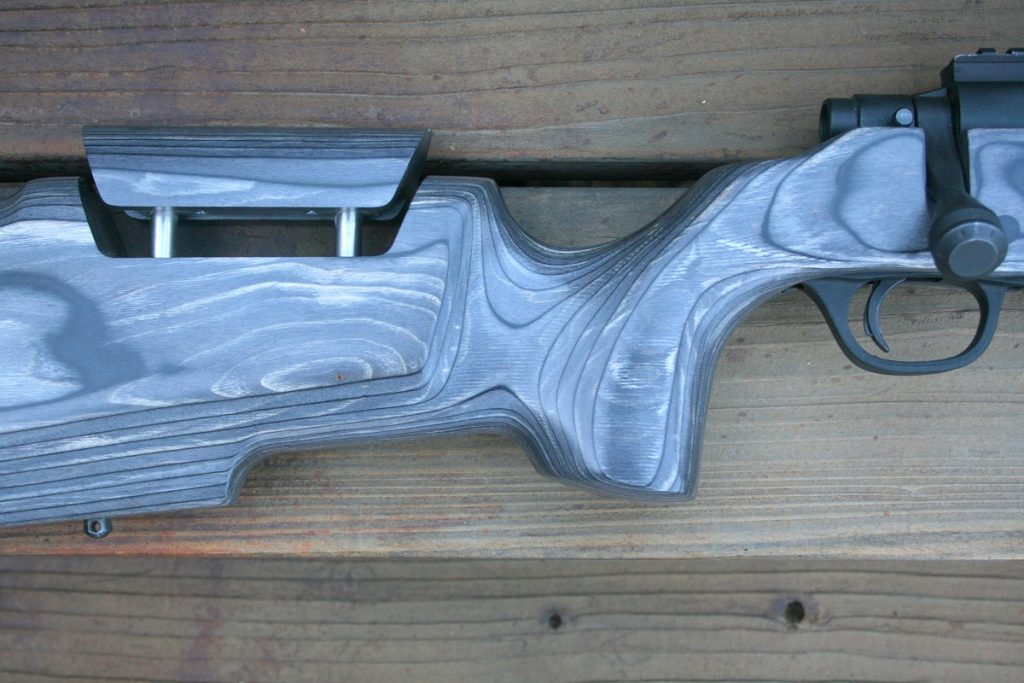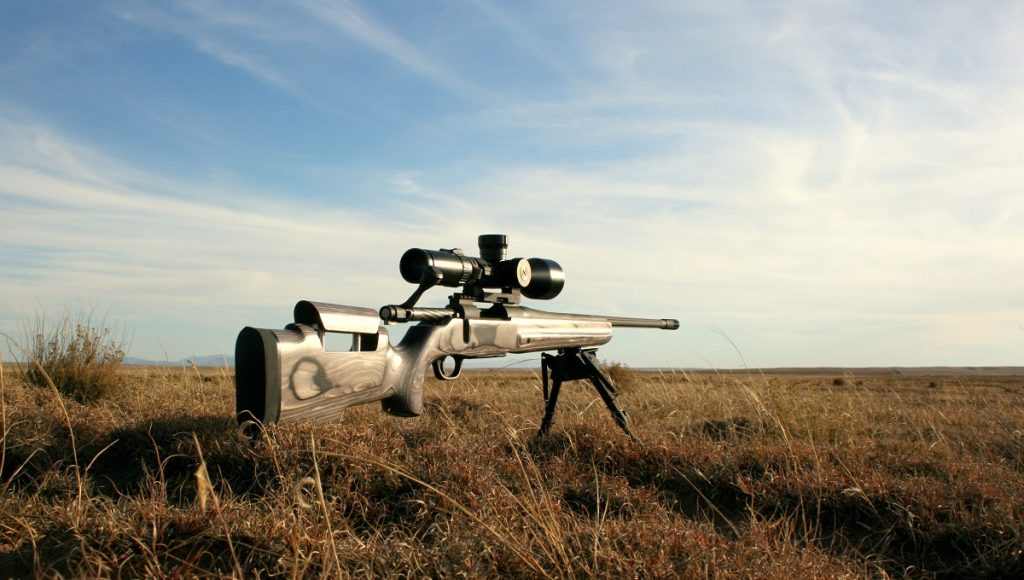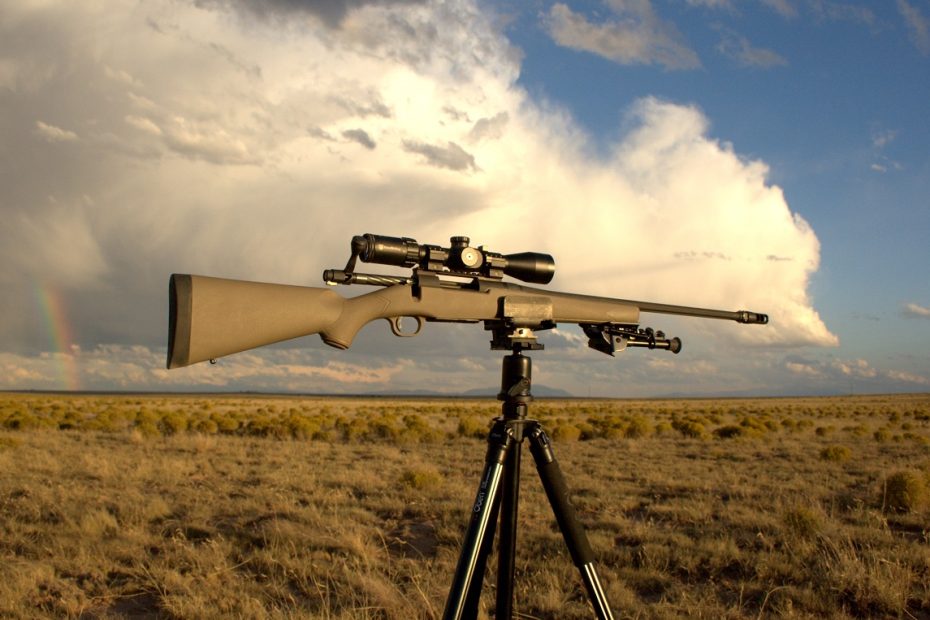Last November I reviewed a Mossberg Patriot Predator chambered in 6.5 Creedmoor. In its stock configuration, I shot the rifle all the way out to 1800 yards and gave it very high marks relative to the price point. Because the Patriot was so accurate, I happily threw the rifle in my testing and training line up, but after several months identified two problems that required attention.

The first was the stock. Mossberg used a composite stock, which is adequate for general hunting or shooting off a bench, but when shooting prone the comb sits too low. I could have built up the comb with foam and “100 mile hour tape” or a nylon pad, but I wanted a modular solution. After assessing my options, I ordered a Boyds Pro Varmint as a replacement for the Mossberg Patriot Predator Stock.




The second issue I found was regarding the scope base. On several occasions, the scope base worked itself loose. Typically, I would be several hours into a test, successfully smashing targets past 1000 yards, when all of a sudden my shots would be several milliradians off. Pushing against the top of the scope would reveal a wobble in the rail, which would require me to pull off the scope, re-tighten the rail, re-zero, and go back to the 1000 yard line. Cleaning the screws and holes in the receiver and applying Loctite did not fix the issue. As a last resort, I used Rocksett, which also failed to secure the rail. The fact that the rail would not stay secured with Rocksett was a giant clue and an indicator that I needed to replace the scope base. A quick call to EGW and I had a 20 MOA base for the Mossberg. I once again cleaned the holes in the receiver, secured the EGW base, dabbed blue Loctite on the base screws and, using a Wheeler FAT wrench, torqued the screws to 20 in/lbs.
Let’s Talk about Rocksett…
In my experience, Rocksett is a permanent solution and should generally be avoided on scope bases. I recommend Blue Loctite, though I will admit that all of my hunting rifles have bases secured with Rocksett. My rationale for using Rocksett is that I do not want to risk a base coming loose while in the backcountry. Scope bases are relatively cheap when you think about the overall cost and time associated with a backcountry hunt, and I would have no problem machining a base off, prior to replacing a barrel.
To Bed or Not to Bed
Without a doubt, bedding the receiver of a rifle to a stock will produce a more accurate rifle. You can buy a bedding kit or take your rifle to a competent gunsmith. Initially, I wanted to purchase a bedding kit, but I was curious what accuracy I would achieve if I simply dropped the Mossberg into the Boyds Pro Varmint, torqued it down, and went to the range. Disassembling the Mossberg Patriot Predator was a breeze. After removing the magazine and the bolt, I loosened the two action screws with a Torx driver. I did a quick wipe down of the receiver and mated it to the Boyds Pro Varmint laminate stock. One thing to note, the composite stock on the Mossberg Patriot Predator has an integrated trigger guard. Boyds includes a polymer trigger guard that is well made and durable. I secured the factory bottom metal and torqued the actions screws at 30 in/lbs. After mating the barreled action to the stock, I attached an MB-4 radial muzzle brake from Adamantium Machine and a Harris Bipod.

Accuracy Testing
Like my original Mossberg test, accuracy testing was conducted at the family ranch. For testing purposes, I used my old Bushnell HDMR rifle scope. The scope is equipped with a Horus H59 reticle and interfaces to a rifle via a LaRue mount. I have used this scope in my testing protocols for years: it tracks, holds zero, and its parallax adjustments are calibrated correctly. All shooting was done in the prone position off of a Harris bipod. During the test, I had a light wind from the 6 o’clock to the 12 o’clock position. Since it was a no value wind, horizontal deflection/aerodynamic jump would not be an issue. I zeroed the rifle with Hornady American Gunner and started my test.
From the chart below you can see my groups. There was no glaring increase or decrease in accuracy, but overall the groups became more consistent. Please note, I used the same lots of ammo as in the initial testing. Confident that the Boyds Pro Varmint did not degrade the accuracy of the system, it was time to start long range testing. For the long range portion, I chose to use 147 grain Hornady MATCH. With a G7 ballistic coefficient of .351, the 147 grain Hornady ELD bullet had the highest ballistic coefficient of all the rounds I tested, and it also grouped a decent 0.62 inches at 100 yards. After checking zero, I got a velocity (2,644 FPS/65 degrees F/DA:8560 feet) with my Magneto Speed chronograph and drove out to the range where I do my long range work.

Long Range Revisited
Long range testing was done on my 2000 yard range. My targets for the shoot were 12, 18, and 24-inch gongs. When I initially tested the Mossberg Patriot Predator, I had first round hits out to 1000 yards shooting in half-value 15-20 mile per hour wind. Knowing what the rifle was capable of doing I drove straight to the 1000 yard line, updated the atmospheric and wind data in my Applied Ballistics Kestrel, held 7.9 mils for elevation and 2.6 mils for wind, and slowly squeezed the trigger. 1.4 seconds later, I watched the 147 ELD MATCH bullet slam into the 12-inch plate. Cycling the Mossberg, I sent another round and was delighted to observe a second impact. Satisfied with that, I made a few notes in my logbook and drove to the 1800 yard line. Consulting my Kestrel at 1800 yards, I would have to hold 21.1 mils for elevation and 4.9 mils for a 20 – 25 mile per hour wind. I dialed 10 mils into my scope and held 11.1 mils in my reticle. At 1800 yards I fired 10 rounds at the 18-inch gong and connected with 5 hits. For fun, I moved back to the 2000 yard line, held 28.7 mils for elevation, and held 7 mils for wind. Out of 10 rounds, I connected twice on the 24-inch plate.



Analysis
The Mossberg Patriot Predator is a very accurate rifle. My initial article demonstrated a lightweight, accurate platform that would be perfect for general hunting. I pushed the rifle pretty hard and found two issues that were easily fixed with aftermarket parts.
Do you need to replace the scope base on the Mossberg Patriot Predator? I am not 100% sure. Mine would not stay on, so it was tossed in the trash and replaced. One advantage of replacing it was that I could go with a 20 MOA base. All of my bolt action rifles have a 20 MOA base. Since I tend to move my scopes around a lot, this makes zeroing more efficient when I move my scope from one rifle to the next.
Do you need to replace the stock on the Mossberg Patriot Predator? If you primarily shoot off a bench or use basic field positions, you will probably be fine with the standard stock. If you zero and shoot in the prone position, an adjustable comb can be a godsend. If you have a child with small craniofacial anatomy, a built-up or adjustable comb would help with getting the perfect sight picture. The same would hold true for female shooters who tend to have higher cheekbones. The Boyds Pro Varmint is a fantastic piece of kit, and I will purchase several for my Tikka and Howa rifles.
Will bedding increase accuracy? Yes. Do I feel that it is necessary to bed this particular rifle? No. Had my groups averaged over 1 MOA, the rifle would have gone straight to my gunsmith for a bedding job. The rifle that I ultimately put together, paired with Hornady 143 ELD-X Precision Hunter, is more than adequate for ethically killing deer-sized animals out to 600 yards and elk out to 400.
Why did I feel the need to shoot the rifle out to 2000 yards? Simply put, because I could. In the “olden days” you had to spend a lot of money and shoot some magnum to be able to hit anything past 1500 yards. In my first article, I shot the factory rifle out to 1800 yards. Since I had slightly better groups with this rifle, a better scope, and a perfect cheek weld, I knew from experience that I could probably get a 20-30% hit ratio if I had a density altitude above 8,000 feet. Pushing out past a mile with factory 6.5 Creedmoor is merely a nod to the current state of the firearm Industry.

Closing
The Mossberg Patriot Predator chambered in 6.5 Creedmoor is a fantastic little rifle. A few hundred dollars will accomplish simple upgrades that grant you a superior shooting experience and push the system’s performance. The Boyds Pro Varmint is an excellent option and a good looking stock! The Boyds Pro Varmint starts at $137, and can be customized at the factory. I strongly recommend the adjustable comb, which allows you to fit a perfect cheek weld.
After wrapping up long range testing, my Mossberg Patriot Predator has been taken out of the safe and used at least a half dozen times. Several hundred rounds have been shot through it and the scope base is still tight and the rifle is simply a pleasure to shoot. As of writing this, the rifle has been loaned out to a close friend for her upcoming deer and oryx hunt. The rifle will also be available for our clients who need a rifle to hunt Pronghorn antelope at our ranch in New Mexico. I have no doubt the rifle will perform.
Visit Boyd to learn more about Boyd’s Pro Varmint stock by clicking [track-link url=”https://www.boydsgunstocks.com/” campaign=”BOYDS_PRO_VARMINT” target=”_blank”]HERE[/track-link].
[track-link url=”https://www.gunsamerica.com/Search/Category/460/Guns/Rifles/Mossberg-Rifles.htm” campaign=”MOSSBERG_RIFLE” target=”_blank”]***Shop GunsAmerica for your next Mossberg Patriot rifle***[/track-link]

